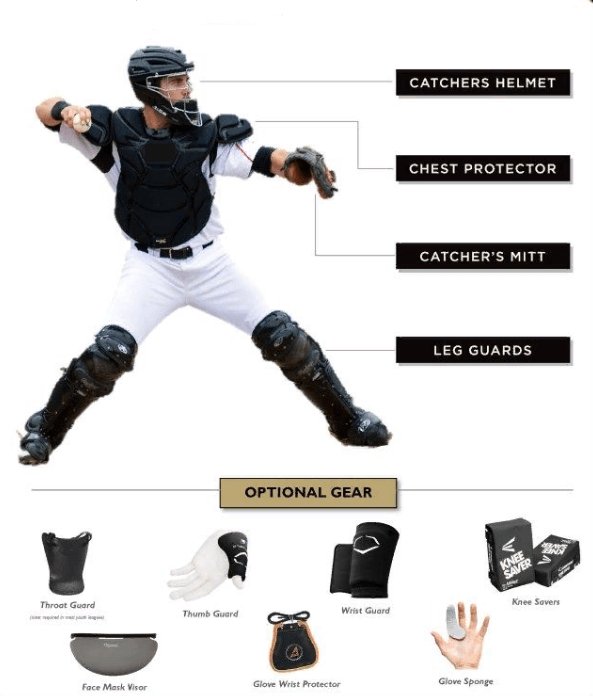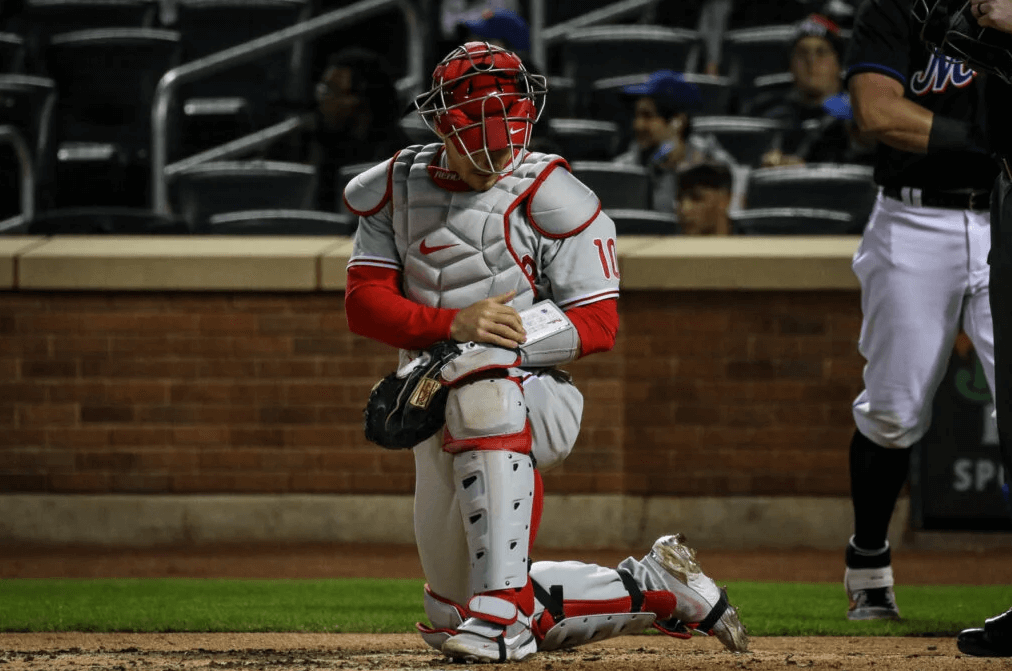The catcher is one of the most important defensive positions in baseball. Located directly behind home plate, the catcher is responsible for receiving pitches thrown by the pitcher and is the on-field leader of the defense. The catcher must catch every pitch, block any pitches in the dirt, and throw out runners attempting to steal bases.
They call the game by selecting pitches and defenses. A good catcher controls the pace and strategy of the game through their strong knowledge of the opposition’s hitters and base runners. Overall, the catcher’s responsibilities go far beyond just catching pitches – they are involved in nearly every defensive aspect of the game.
Equipment

A catcher wears protective gear to shield their body from wild pitches behind the plate. This includes a catcher’s mask to protect the face, a chest protector to guard the torso, and shin guards to shield the legs. The catcher’s mask is a wire face guard with a padded helmet to absorb impacts from balls and prevent injuries. Chest protectors are padded armor that cushions the body. Shin guards have hard plastic shields covering the knee and calf to block foul tips and prevent bruises.
This specialized protective equipment is essential for catchers to withstand the physical demands of the position. High quality, durable gear helps minimize injuries and allows catchers to focus on fielding balls, throwing out runners, and guiding the pitcher without fear or distraction.
Receiving Pitches
The catcher’s main responsibility is receiving pitches from the pitcher. This involves “catching” each pitch in his mitt and preventing wild pitches and passed balls.
Catchers use proper technique to catch pitches quietly and smoothly. This involves moving the mitt in toward the strike zone to meet the pitch and cushioning the ball on impact. A good catcher makes each catch look easy and effortless.
Framing pitches is another key receiving skill. This involves subtly moving the mitt to make borderline pitches appear as strikes to the umpire. Skilled catchers can steal extra strike calls by framing pitches just outside the strike zone. Framing takes fast reflexes, soft hands, and a mental grasp of the strike zone’s contours. It allows pitchers to expand the zone and keeps hitters off-balance.
The catcher must provide a stable, consistent target for the pitcher to throw to. He sets up in his stance and presents a visible mitt in or near the strike zone. The catcher remains still through each pitch, receiving it quietly without pulling the ball or popping up. This gives the umpire a clear look at each pitch’s location. A catcher who provides a solid target helps pitchers maintain command and consistency.
Blocking Pitches

A key responsibility for catchers is blocking pitches in the dirt to prevent wild pitches and passed balls. Catchers use their body, chest protector, shin guards, and mitt to keep balls in front of them. Effective blocking requires getting low into an athletic stance, moving the body to square up in front of the ball, and smothering the ball with protective gear. The catcher must stay relaxed and loose to react quickly when balls bounce unpredictably. A good blocking technique is crucial for preventing base runners from advancing and keeping runs off the board.
Catchers also work on blocking drills to prepare for plays at the plate. By keeping their knees bent and staying low to the ground, catchers can effectively block the plate and prevent base runners from sliding in safely. Catchers practice setting up in the proper blocking position at the plate and learning how to receive throws while protecting the plate with their shin guards. Solid blocking skills help catchers control the run game.
Throwing Runners Out
A key responsibility for catchers is controlling the running game by throwing out baserunners attempting to steal. The catcher’s “pop time” measures their throwing effectiveness. Pop time combines the catcher’s exchange time (release of the ball) with their throwing velocity to second base.
Elite MLB catchers can achieve pop times under 1.90 seconds. For example, Tomás Nido of the Mets led MLB in 2021 with an average pop time of 1.88 seconds. This requires near-perfect footwork, a quick exchange, plus exceptional arm strength exceeding 85 mph on throws to second base.
Accuracy is equally important. Catchers must make accurate throws within the base path to record outs. They aim for the second baseman’s chest on steal attempts. Plus they must adjust for pitch location and the baserunner’s jump. With thousands of throws over a season, catching requires consistent precision.
Calling the Game

Calling the game is one of the most important responsibilities for a catcher. The catcher works closely with the pitcher to strategize each at-bat and decide which pitches to throw. They act as an on-field coach, using their knowledge of the game situation, the opposing hitters’ tendencies, and their own pitcher’s strengths and weaknesses to call the right pitch at the right time.
The catcher and pitcher will often meet together before the game or in between innings to discuss their approach. They’ll review the opposing lineup and identify high-risk hitters to pitch carefully to. The catcher has to balance aggressiveness and playing it safe, pushing the pitcher when possible but not overexerting. A good catcher builds trust with the pitching staff by calling a smart game.
During each at-bat, the catcher flashes signs to signal the pitch type and location. They’ll mix up the signs to keep the opposition guessing. The catcher may call for a waste pitch early in the count to set up a strikeout pitch later, or an off-speed pitch when the batter is gearing up for a fastball. If the pitcher struggles, the catcher takes some blame too for calling the wrong pitch. The catcher’s pitch selection directly impacts the outcome of the game.
Defense
The catcher is responsible for coordinating the defense and positioning the fielders before each pitch. They must make sure all infielders are in the proper position for each batter and adjust based on game situations.
Some key defensive duties include:
-
Positioning themselves properly based on the count, number of outs, and runners on base. The catcher generally sets up directly behind the plate, but may shift position for certain batters or situations.
-
Positioning the infielders and signaling where to play certain hitters. For example, moving the third baseman in closer for a lefty pull hitter. The catcher communicates these adjustments through hand signals before the pitch.
-
Providing instruction to infielders on situational plays during the game. For example, reminding the first baseman to look for a force out at home when there’s a runner on third base.
-
Coordinating rundown plays between infielders when a runner is caught in a pickle. The catcher will shout instructions so each fielder knows when to run towards the runner or cut off their angle.
-
Backing up infielders on errant throws that pull them off their normal position. The catcher must rotate to cover areas left open from infielders moving to field a ball.
Proper positioning and communication from the catcher is crucial for the infield defense to work as a cohesive unit. Their defensive leadership ties the whole infield together.
Hitting

In addition to their defensive duties, catchers also play an important role offensively for their teams. Though not known for hitting for high averages, catchers are often counted on for power and run production in the middle-to-bottom part of batting orders.
Many catchers excel at switch hitting, giving them an advantage against both right-handed and left-handed pitchers. Switch hitting helps relieve some of the physical strain from repeatedly batting on just one side as well. Catchers are also adept at situational hitting, skilled at moving runners over, executing sacrifice bunts, and driving in runs with productive outs when needed. Their situational hitting abilities make them integral parts of manufacturing runs.
Training
A catcher’s training regimen focuses on building strength, stamina, and improving skills. Conditioning is crucial since catchers need to squat for long periods and withstand the physical toll of blocking pitches. Common strength training exercises include squats, deadlifts, and Olympic lifts to build lower body power. Core stability is also important for transferring energy from the legs to the upper body when throwing.
Catchers practice receiving skills like framing, blocking, and transferring the ball from the glove to throw. Drills include receiving balls from pitching machines, blocking various pitches in the dirt, and quick transfer throws to bases. Throwing accuracy is honed through repetition. Catchers work on building arm strength as well since they need to make strong, accurate throws up to 120 feet to second base. Maintaining flexibility in the hips, legs, and ankles through stretching helps with the crouched stance. Running sprints develops speed for stealing bases.
Conclusion
The catcher is one of the most important and demanding positions in baseball. As the on-field leader, the catcher is responsible for calling pitches, blocking balls in the dirt, throwing out runners, and more. They must have tremendous physical skills like arm strength and agility as well as mental skills like game planning and reading batters.
Throughout baseball history, legendary catchers like Johnny Bench, Yogi Berra, and Mike Piazza have anchored championship teams with their defensive and offensive prowess. The modern game continues to see great catchers like Buster Posey and Yadier Molina carry on this tradition.
The catcher position requires specialized skills and constant dedication. By controlling the game behind the plate and contributing offensively, great catchers give their team an edge. Their importance to a team’s success cannot be overstated. The catcher truly is one of baseball’s most demanding and influential positions.








